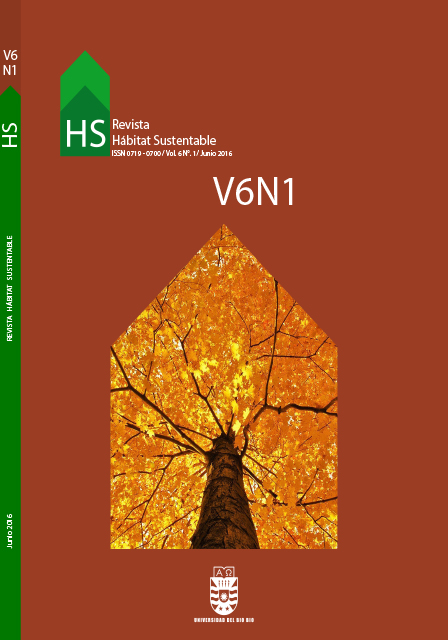Estrategia para la incorporación de impactos ambientales, sociales y económicos específicos en un método de evaluación de la sostenibilidad de edificios de salud (HBSA method)
DOI:
https://doi.org/10.22320/07190700.2016.06.01.04Palabras clave:
los métodos de evaluación, método HBSA, edificios de salud, hospitales, sostenibilidadResumen
El proyecto de un ambiente hospitalario requiere una serie de preocupaciones por la satisfacción y el bienestar del equipo de trabajo, pacientes y administradores, a la vez que posee una fuerte responsabilidad social e impacto en la ciudad. Actualmente, veré que la mayoría de este tipo
de edificios no es concebida o utilizada de forma sostenible, a pesar de que ya existen algunas herramientas que se están desarrollando con el objetivo de ser utilizadas en el soporte de decisiones que permitan optimizar la sostenibilidad de los mismos. Sobre la base de este contexto,
el presente artículo tiene como objetivos discutir las barreras existentes en la diseminación de prácticas sostenibles en los edificios de salud y presentar una propuesta de estructura para una metodología que, dando respuesta a algunas de las barreras identificadas, facilite la incorporación de principios de sustentabilidad durante las diferentes fases del ciclo de vida de un edificio hospitalario. La estructura presentada es orientada al contexto portugués y se encuentra basada en el trabajo desarrollado hasta entonces por las organizaciones ISO y CEN y en otras metodologías internacionales de evaluación de la sostenibilidad ya disponibles en el mercado.
Descargas
Citas
ACSS. Recomendações e especi cações técnicas do Edifício Hospitalar. 2011. Lisboa: ACSS - Administração Central do Sistema de Saúde, 2012.
ACSS. Guia de boas práticas para o sector da saúde. 1.3 (2013). Lisbon: ACSS, 2013.
ACSS. Portal da Saúde [online], 2016. [Dta de consulta: 14 de maio 2016]. Disponível em: http://www.portaldasaude.pt/portal.
ASHE. Green healthcare construction guidance statement. Chicago: ASHE, 2002.
BAUM, Mara e SHEPLEY, Mardelle. Eco-Effective Design & Evidence- Based Design. Documento apresentado em: Cleanmed. Chicago, 2009, pp. 1–63.
BAUM, Mara; SHEPLEY, Mardelle; GINSBERG, Rachel e ROSTENBERG, Bill. Eco-Effective Design and Evidence-Based Design: Perceived Synergy and Con ic. HERD, 2009a, vol. 2, no. 3, pp. 56–70.
BAUM, Mara; SHEPLEY, Mardelle; ROSTENBERG, Bill e GINSBERG, Rachel. Eco-Effective Design and Evidence-Based Design: Removing Barriers to Integration. 1. San Francisco: AIA Board Knowledge Committee, 2009b.
CASTRO, Maria de Fátima; MATEUS, Ricardo e BRAGANÇA, Luís. Proposal for a Healthcare Building Sustainability Assessment (HBSA) Method. Em: World SB14 Barcelona. vol. 5. Barcelona: GBCe, 2014, pp. 607–613.
CASTRO, Maria de Fátima; MATEUS, Ricardo e BRAGANÇA, Luís. A critical analysis of building sustainability assessment methods for healthcare buildings. Environment, Development and Sustainability, 2015a, vol. 17, no. 6, pp. 1381–1412.
CASTRO, Maria de Fátima; MATEUS, Ricardo e BRAGANÇA, Luís. Estratégia para a incorporação de impactes ambientais, sociais e económicos especí cos num método de Avaliação da Sustentabilidade de Edifícios de Saúde (HBSA). Em: Latin American European Conference on Sustainable Buildings and Communities. EURO ELECS 2015, Guimarães, 2015b.
CASTRO, Maria de Fátima; MATEUS, Ricardo; BRAGANÇA, Luís e SERÔDIO, Francisco. Development of Benchmarks for Operating Costs and Resources Consumption to be Used in Healthcare Building Sustainability Assessment Methods. Sustainability, 2015, vol. 7, no. 10, pp. 13222–13248.
GUENTHER, Robin e VITTORI, Gail. Sustainable healthcare architecture. 1. Nova Jérsia: John Wiley & Sons, Inc., 2008.
GUENTHER, Robin e VITTORI, Gail. Sustainable healthcare architecture. 2. Nova Jérsia: John Wiley & Sons, Inc., 2013
HAMILTON, Kirk. Four Levels of Evidence-Based Practice. AIA Journal of Architecture. Nova Iorque: AIA, 2006, pp. 1–2.
ISO TS. ISO/AWI 21929, Building Construction – Sustainability in Building Construction – Sustainability Indicators - Part 1 - Framework for the development of indicators for buildings and core indicators. 2010. Geneva: ISO, 2010.
LEE, Wai-ling; CHAU, Chi-kwan; YIK, Francis; BURNETT, John e TSE, Man Sze. On the study of the credit-weighting scale in a building environmental assessment scheme. Building and Environment, 2002, vol. 37, no. 12, pp. 1385–1396.
MATEUS, Ricardo. Avaliação da Sustentabilidade da Construção. Guimarães: Escola de Engenharia da Universidade do Minho, 2009.
PENTLAND, William. Heal Thy Self: U.S. Hospitals Are Huge Energy Hogs. Forbes [online] [Data de consulta: 17 de outubro de 2013]. Disponível em: http://www.forbes.com/sites/ williampentland/2012/08/20/u-s-hospitals-are-huge-energy-hogs- better-light-bulbs-are-not-the-solution/.
ROBERTS, Greg e GUENTHER, Robin. Environmentally Responsible hospitals. Em: S. MARBERRY (ed.), Improving healthcare with better building design. 1. Chicago: Health Administration Press, 2006, pp. 81–107.
VAQUERO, Petra. Edifícios de saúde: Qual o caminho para a e ciência energética? Em: A. MALHEIRO (ed.), Tecno Hospital – revista de engenharia e gestão da saúde. vol. 58. Lisboa: EH ATEHP, 2013, pp. 18–20.
Descargas
Publicado
Cómo citar
Número
Sección
Licencia
Derechos de autor 2016 Hábitat Sustentable

Esta obra está bajo una licencia internacional Creative Commons Atribución-CompartirIgual 4.0.
El contenido de los artículos que se publican en cada número de Hábitat Sustentable, es responsabilidad exclusiva de los autores y no representan necesariamente el pensamiento ni comprometen la opinión de la Universidad del Bío-Bío.
Los autores/as conservarán sus derechos de autor y garantizarán a la revista el derecho de primera publicación de su obra, el cuál estará simultáneamente sujeto a la Licencia de Reconocimiento de Creative Commons CC BY-SA que permite a otros compartir-copiar, transformar o crear nuevo material a partir de esta obra con fines no comerciales, siempre y cuando se reconozcan la autoría y la primera publicación en esta revista, y sus nuevas creaciones estén bajo una licencia con los mismos términos.











 Programa de Información Científica/Concurso Fondos de Publicación de Revistas Científicas 2018/ Proyecto Mejoramiento de Visibilidad de Revistas UBB (Código:FP180007)
Programa de Información Científica/Concurso Fondos de Publicación de Revistas Científicas 2018/ Proyecto Mejoramiento de Visibilidad de Revistas UBB (Código:FP180007) 





